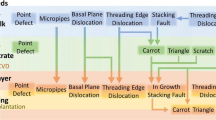Abstract
Crystalline (including multicrystalline) silicon based devices dominate the present solar cell industry due to their durability, relatively low cost, and the vast silicon knowledge base developed by the microelectronics industry. Multicrystalline silicon is the becoming dominating substrate material of the photovoltaic cells. This is obviously due to the significant cost savings compared with the single crystalline silicon wafers. Consequently, the conversion efficiency of the mc-Si solar cell is suffering because of the low cost requirement of the starting materials. One contributor to the lower performance of the mc-Si cells is the grain boundaries which reduce the charge carrier collection properties. Thus, reducing solar cell fabricate is an attractive way to reduce material costs. However, the model calculations in the presented paper show that the rear surface recombination velocity (S) in multicrystalline silicon cell is greater than (mc-Si) cell and the efficiency of mc-Si cell is lower than the efficiency of a crystalline cell.
Similar content being viewed by others
References
Axelevitch A, Palankovski V, Selberherr S, Golan G (2014) Investigation of novel silicon PV cells of a lateral type. In: Silicon, pp 1–9
Slaoui A, Siffert P (2004) Polycrystalline silicon films for electronic devices. In: Silicon, pp 49–72
Muller JC, Siffert P (2004) Silicon for photovoltaics. In: Silicon, pp 73–92
Dornich K, Schüler N, Berger B, Niklas JR (2013) Fast, high resolution, inline contactless electrical semiconductor characterization for photovoltaic applications by microwave detected photoconductivity. Mater Sci Eng B
Rohatgi A, Ebong A, Yelundur V, Ristow A (1999) Rapid thermal processing of next generation silicon solar cells. In: 10th international workshop on the physics of semiconductor devices, pp 14–18
Schneider A et al (2001) Al BSF for thin screenprinted multicrystalline Si solar cells. In: 17th EU-PVSEC
Aberle A, Warta W, Knobloch J, Voss B (1990) Surface passivation of high efficiency silicon solar cells, In: 21st IEEE PVSC, pp 233–238
Lauinger T, Schmidt J, Aberle A, Hezel R (1996) Recond low surface recombination velocities on 1 Ω-cm psilicon using remote plasma silicon nitride passivation. Appl Phys Lett 68:1232–1234
Koval T, Wohlegemuth J, Kinsey B (1996) Dependence of cell performance on wafer thickness for BSF and non-BSF cells. In: 25th IEEE PVSC, pp 505–507
Schulenburg H, Tributsch H (2000) Electropassivation of silicon and bulk lifetime determination with dry polymer contact. J Phys D 33:851–858
Brody J, Rohatgi A (2002) Sensitivity analysis of twospectrum separation of surface and bulk components of minority carrier lifetime. Solid State Electron 46:859–866
M’Saad H, Michel J, Lappe JJ, Kimerling LC (1994) Electronic passivation of silicon surfaces by halogens. J Elec Mat 23:487– 491
Bail M, Brendel R (2000) Separation of bulk and surface recombination by steady state photoconductance measurements.” In: 16th European PV conference
Macdonald D, Sinton RA, Cuevas A (2001) On the use of a bias-light correction for trapping effects in photoconductance- based lifetime measurements of silicon. J Appl Phys 89:2772– 2778
O’Regan B, Grätzel M (1991) Nature 353:737
Bisquert J, Zaban A, Salvador P (2002) J Phys Chem B 106:8774
Montanari I, Nelson J, Durrant JR (2002) J Phys Chem B 106:12203
Schlichthörl G, Huang SY, Sprague J, Frank AJ (1997) J Phys Chem B 101:8141
Fisher AC, Peter LM, Ponomarev EA, Walker AB, Wijayantha KGU (2000) J Phys Chem B 104:949
Södergren S, Hagfeldt A, Olsson J, Lindquist SE (1994) J Phys Chem 98:5552
Tools CJJ, Burgers AR, Manshanden P, Weeber AW, von Straaten BHM (2002) Influence of wafer thickness on the performance of multicrystalline Si solar cells: an Experimental Study. Prog Photovolt Res Appl 10:279–291
Author information
Authors and Affiliations
Corresponding author
Rights and permissions
About this article
Cite this article
El-Amin, A.A. Study of the Electron Lifetime in Crystalline and Multicrystalline Si Solar Cells. Silicon 7, 297–302 (2015). https://doi.org/10.1007/s12633-014-9275-2
Received:
Accepted:
Published:
Issue Date:
DOI: https://doi.org/10.1007/s12633-014-9275-2




